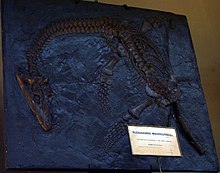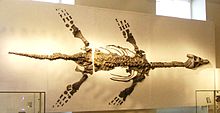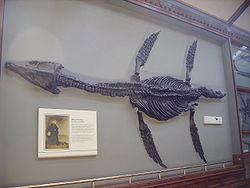Khác biệt giữa bản sửa đổi của “Thằn lằn đầu rắn”
Không có tóm lược sửa đổi |
|||
| Dòng 23: | Dòng 23: | ||
Những plesiosaur sớm nhất xuất hiện chủ yếu từ [[Trung Trias]],<ref>Benton M.J. 1990. ''The reign of the reptiles''. Quarto N.Y.</ref><sup>p128</sup> và phát triển cực thịnh trong kỉ [[Jurassic|Jura]] và kỉ [[Cretaceous|Creta]]. Chúng có hai cặp vây chèo lướn,đuôi ngắn, cổ ngắn hoặc dài, và cơ thể to lớn. Chúng tuyệt chủng trong [[Sự kiện tuyệt chủng kỷ Creta-Paleogen|sự kiện tuyệt chủng K-T]] vào 65 triệu năm trước.<ref>Carroll R.L. 1988. ''Vertebrate paleontology and evolution''. Freeman N.Y.</ref> |
Những plesiosaur sớm nhất xuất hiện chủ yếu từ [[Trung Trias]],<ref>Benton M.J. 1990. ''The reign of the reptiles''. Quarto N.Y.</ref><sup>p128</sup> và phát triển cực thịnh trong kỉ [[Jurassic|Jura]] và kỉ [[Cretaceous|Creta]]. Chúng có hai cặp vây chèo lướn,đuôi ngắn, cổ ngắn hoặc dài, và cơ thể to lớn. Chúng tuyệt chủng trong [[Sự kiện tuyệt chủng kỷ Creta-Paleogen|sự kiện tuyệt chủng K-T]] vào 65 triệu năm trước.<ref>Carroll R.L. 1988. ''Vertebrate paleontology and evolution''. Freeman N.Y.</ref> |
||
==Classification== |
|||
===Taxonomy=== |
|||
[[File:Kronosaurus BW.jpg|thumb|right|''[[Kronosaurus]]'', a [[pliosaurid]]]] |
|||
[[File:Thalassomedon BW.jpg|thumb|right|''[[Thalassomedon]]'', an [[elasmosaurid]]]] |
|||
[[File:Dolichorhynchops BW.jpg|thumb|right|''[[Dolichorhynchops]]'', a [[polycotylid]]]] |
|||
The taxonomy presented here is mainly based on the plesiosaur cladistic analyses proposed by Ketchum and Benson, 2011 and Benson et al., 2012 unless otherwise noted.<ref name=Bensonetal12>{{cite journal |year=2012 |title=High Diversity, Low Disparity and Small Body Size in Plesiosaurs (Reptilia, Sauropterygia) from the Triassic–Jurassic Boundary |url=http://www.plosone.org/article/fetchObjectAttachment.action?uri=info%3Adoi%2F10.1371%2Fjournal.pone.0031838&representation=PDF |journal=PLoS ONE |volume=7 |issue=3 |pages=e31838 |doi=10.1371/journal.pone.0031838 |pmid=22438869 |pmc=3306369 |author=Roger B. J. Benson, Mark Evans and Patrick S. Druckenmiller |editor1-last=Lalueza-Fox |editor1-first=Carles}}</ref><ref name=Marmornectes>{{cite journal |year=2011 |title=A new pliosaurid (Sauropterygia, Plesiosauria) from the Oxford Clay Formation (Middle Jurassic, Callovian) of England: evidence for a gracile, longirostrine grade of Early-Middle Jurassic pliosaurids |journal=Special Papers in Palaeontology |volume=86 |issue= |pages=109–129 |doi=10.1111/j.1475-4983.2011.01083.x |author=Hilary F. Ketchum and Roger B. J. Benson }}</ref> In this [[taxonomic rank|rank]]-based list, the traditional suborders Plesiosauroidea and Pliosauroidea are maintained but the short-necked Leptocleididae and Polycotylidae, which traditionally had been seen as Pliosauroidea, have been placed in the Plesiosauroidea, reflecting their evolutionary position according to these studies. |
|||
* Clade [[Pistosauria]] |
|||
** ''[[Augustasaurus]]'' |
|||
** ''[[Pistosaurus]]'' |
|||
** ''[[Yunguisaurus]]'' |
|||
** '''Order Plesiosauria''' |
|||
*** ''[[Bobosaurus]]'' |
|||
*** '''Suborder [[Plesiosauroidea]]''' |
|||
**** Family [[Elasmosauridae]] |
|||
**** Family [[Microcleididae]] |
|||
**** Family [[Plesiosauridae]] |
|||
**** Clade Cryptoclidia |
|||
*****? Family [[Aristonectidae]] |
|||
***** Family [[Cryptoclididae]] |
|||
***** Clade Leptocleidia |
|||
****** Family [[Leptocleididae]] |
|||
****** Family [[Polycotylidae]] |
|||
*** '''Suborder [[Pliosauroidea]]''' |
|||
****? Family [[Rhomaleosauridae]] |
|||
**** Family [[Pliosauridae]] |
|||
===Phylogeny=== |
|||
In modern [[phylogeny]], [[clade]]s are defined groups that [[Monophyly|contain all species belonging to a certain branch of the evolutionary tree]]. One way to define a clade is to let it consist of the [[last common ancestor]] of two such species and all its descendants. Such a clade is called a "[[node-based taxon|node clade]]". In 2008, [[Patrick Druckenmiller]] and [[Anthony Russell]] in this way defined Plesiosauria as the group consisting of the last common ancestor of ''[[Plesiosaurus]] dolichocheirus'' and ''[[Peloneustes]] philarchus''; and all its descendants.<ref>Druckenmiller, P.S. & Russell, A.P., 2008, ''A phylogeny of Plesiosauria (Sauropterygia) and its bearing on the systematic status of'' Leptocleidus ''Andrews, 1922''. Zootaxa 1863. Aukland: Magnolia Press</ref> ''Plesiosaurus'' and ''Peloneustes'' represented the main subgroups of the Plesiosauroidea and the Pliosauroidea and were chosen for historical reasons; any other species from these groups would have sufficed. |
|||
Another way to define a clade is to let it consist of all species more closely related to a certain species that one in any case wishes to include in the clade, than to another species that one to the contrary desires to exclude. Such a clade is called a "[[stem-based taxon|stem clade]]". Such a definition has the advantage that it is easier to include all species with a certain [[Morphology (biology)|morphology]]. Plesiosauria was in 2010 by [[Hillary Ketchum]] and [[Roger Benson]] defined as such a [[stem-based taxon]]: "all taxa more closely related to ''[[Plesiosaurus dolichodeirus]]'' and ''[[Pliosaurus brachydeirus]]'' than to ''[[Augustasaurus hagdorni]]''". Ketchum and Benson (2010) also coined a new clade Neoplesiosauria, a [[node-based taxon]] that was defined by as "''Plesiosaurus dolichodeirus'', ''Pliosaurus brachydeirus'', their most recent common ancestor and all of its descendants".<ref name="Ketchum2010">{{cite journal |last1=Ketchum |first1=H.F. |last2=Benson |first2=R.B.J. |year=2010 |title=Global interrelationships of Plesiosauria (Reptilia, Sauropterygia) and the pivotal role of taxon sampling in determining the outcome of phylogenetic analyses |journal= Biological Reviews of the Cambridge Philosophical Society |volume=85 |issue=2 |pages=361–392 |doi=10.1111/j.1469-185X.2009.00107.x |pmid=20002391}}</ref> Neoplesiosauria very likely is materially identical to Plesiosauria ''sensu'' Druckenmiller & Russell and was meant to be a replacement of this concept. The following [[cladogram]] follows an analysis by Ketchum & Benson, 2011.<ref name=Marmornectes/> |
|||
[[File:Macrocephalus.jpg|thumb|Cast of "Plesiosaurus" ''macrocephalus'', yet to receive a valid genus name]] |
|||
<div class="noprint"> |
|||
{{clade| style=font-size:85%;line-height:85% |
|||
|label1= [[Pistosauria]] |
|||
|1={{clade |
|||
|1="''Pistosaurus'' postcranium" |
|||
|2={{clade |
|||
|1=''[[Augustasaurus hagdorni]]'' |
|||
|2=''[[Bobosaurus forojuliensis]]'' |
|||
|3=''[[Pistosaurus]]'' |
|||
|4=''[[Yunguisaurus liae]]'' |
|||
|label5= '''Plesiosauria''' |
|||
|5={{clade |
|||
|label1= [[Pliosauroidea]] |
|||
|1={{clade |
|||
|label1= [[Pliosauridae]] |
|||
|1={{clade |
|||
|1=''[[Thalassiodracon hawkinsii]]'' |
|||
|2={{clade |
|||
|1=''[[Hauffiosaurus]] spp.'' |
|||
|2={{clade |
|||
|1=''[[Attenborosaurus conybeari]]'' |
|||
|2=advanced pliosaurids }} }} }} |
|||
|label2= [[Rhomaleosauridae]] |
|||
|2={{clade |
|||
|1=NHMUK 49202 [now ''[[Anningasaura lymense]]''] |
|||
|2={{clade |
|||
|1=advanced rhomaleosaurids |
|||
|2={{clade |
|||
|1=''"[[Plesiosaurus]]" macrocephalus'' |
|||
|2={{clade |
|||
|1=''[[Archaeonectrus rostratus]]'' |
|||
|2=''[[Macroplata tenuiceps]]'' }} }} }} }} }} |
|||
|label2= [[Plesiosauroidea]] |
|||
|2={{clade |
|||
|1=OUMNH J.10337 [now ''[[Stratesaurus taylori]]''] |
|||
|2={{clade |
|||
|label1= [[Plesiosauridae]] |
|||
|1={{clade |
|||
|1=''[[Seeleyosaurus guilelmiimperatoris]]'' |
|||
|2={{clade |
|||
|1=OUMNH J.28585 |
|||
|2=''[[Plesiosaurus dolichodeirus]]'' }} }} |
|||
|2={{clade |
|||
|1='''[[Elasmosauridae]] and [[Cryptoclidia]]''' |
|||
|2={{clade |
|||
|1=''[[Microcleidus homalospondylus]]'' |
|||
|2={{clade |
|||
|1=''[[Hydrorion brachypterygius]]'' |
|||
|2=''[[Occitanosaurus tournemiensis]]'' }} }} }} }} }} }} }} }} }} |
|||
</div> |
|||
Benson ''et al.'' (2012) found the traditional Pliosauroidea to be [[paraphyletic]] in relation to Plesiosauroidea. Rhomaleosauridae was found to be outside Neoplesiosauria, but still within Plesiosauria. The early [[carnian]] pistosaur ''[[Bobosaurus]]'' was found to be more advanced than ''[[Augustasaurus]]'' in relation to the Plesiosauria and therefore it represents by definition the oldest known plesiosaur. However, the authors excluded ''Bobosaurus'' from this clade without any explanation, although that exclusion might be a typo in the article. This analysis focused on basal plesiosaurs and therefore only one derived pliosaurid and one [[cryptoclidia]]n were included, while [[Elasmosauridae|elasmosaurid]]s weren't included at all. The cladogram below follows the topology from Benson et al. (2012) analysis.<ref name=Bensonetal12/> |
|||
[[File:Plesiosaur skeleton, New Walk Museum.JPG|thumb|"Rhomaleosaurus" ''megacephalus'', yet to receive a valid genus name]] |
|||
<div class="noprint"> |
|||
{{clade| style=font-size:85%;line-height:85% |
|||
|label1= [[Pistosauria]] |
|||
|1={{clade |
|||
|1="''Pistosaurus'' postcranium" |
|||
|2=''[[Pistosaurus]]'' |
|||
|3=''[[Yunguisaurus liae]]'' |
|||
|4={{clade |
|||
|1=''[[Augustasaurus hagdorni]]'' |
|||
|label2= '''Plesiosauria''' |
|||
|2={{clade |
|||
|1=''[[Bobosaurus forojuliensis]]'' |
|||
|2={{clade |
|||
|1=NHMUK 49202 [now ''[[Anningasaura lymense]]''] |
|||
|2={{clade |
|||
|label1= [[Rhomaleosauridae]] |
|||
|1={{clade |
|||
|1=''[[Stratesaurus taylori]]'' |
|||
|2={{clade |
|||
|1=''[[Macroplata tenuiceps]]'' |
|||
|2={{clade |
|||
|1=''[[Avalonnectes arturi]]'' |
|||
|2={{clade |
|||
|1=''[[Eurycleidus arcuatus]]'' |
|||
|2={{clade |
|||
|1=''[[Meyerasaurus victor]]'' |
|||
|2={{clade |
|||
|1=''[[Maresaurus coccai]]'' |
|||
|2={{clade |
|||
|1=''[[Rhomaleosaurus megacephalus|"Rhomaleosaurus" megacephalus]]'' |
|||
|2={{clade |
|||
|1=''[[Archaeonectrus rostratus]]'' |
|||
|2={{clade |
|||
|1=''[[Rhomaleosaurus cramptoni]]'' |
|||
|2={{clade |
|||
|1=''[[Rhomaleosaurus thorntoni]]'' |
|||
|2=''[[Rhomaleosaurus zetlandicus]]'' }} }} }} }} }} }} }} }} }} }} |
|||
|label2=Neoplesiosauria |
|||
|2={{clade |
|||
|label1= [[Pliosauridae]] |
|||
|1={{clade |
|||
|1=''[[Thalassiodracon hawkinsii]]'' |
|||
|2={{clade |
|||
|1=''[[Hauffiosaurus]] spp.'' |
|||
|2={{clade |
|||
|1=''[[Attenborosaurus conybeari]]'' |
|||
|2=advanced pliosaurids (''[[Peloneustes]]'') }} }} }} |
|||
|label2= [[Plesiosauroidea]] |
|||
|2={{clade |
|||
|1=''[[Eoplesiosaurus antiquior]]'' |
|||
|2={{clade |
|||
|1=''[[Plesiosaurus dolichodeirus]]'' |
|||
|2={{clade |
|||
|1={{clade |
|||
|1=''[[Plesiopterys wildi]]'' |
|||
|2=''[[Cryptoclidus eurymerus]]'' }} |
|||
|label2= [[Microcleididae]] |
|||
|2={{clade |
|||
|1=''[[Eretmosaurus rugosus]]'' |
|||
|2=''[[Westphaliasaurus simonsensii]]'' |
|||
|3={{clade |
|||
|1=''[[Seeleyosaurus guilelmiimperatoris]]'' |
|||
|2={{clade |
|||
|1=''[[Microcleidus tournemiensis]]'' |
|||
|2={{clade |
|||
|1=''[[Microcleidus brachypterygius]]'' |
|||
|2=''[[Microcleidus homalospondylus]]'' }} }} }} }} }} }} }} }} }} }} }} }} }} }} |
|||
</div> |
|||
== Đặc điểm == |
== Đặc điểm == |
||
Phiên bản lúc 18:33, ngày 26 tháng 3 năm 2015
| Plesiosaur | |
|---|---|
| Thời điểm hóa thạch: Trung Trias to Creta muộn | |
 | |
| Phân loại khoa học | |
| Giới (regnum) | Animalia |
| Ngành (phylum) | Chordata |
| Lớp (class) | Reptilia |
| Liên bộ (superordo) | Sauropterygia |
| Bộ (ordo) | Plesiosauria |
| Phân bộ (subordo) | Gray, 1825 |
| Họ | |
Plesiosaurs là một bộ các bò sát biển lớn, ăn thịt. Chúng tồn tại và phát tiển từ khoảng 245 triệu ănm trước (mya) tới 65 mya.
Mary Anning là người đầu tiên phát hiện ra plesiosaur. Bà dã tìm thấy nó ở 'Jurassic Coast' tại Dorset, Anh trong mùa đông cuối năm 1820 đầu năm 1821. Hóa thạch này đã bị mất hộp sọ, nhưng vào năm 1823 bà đã tìm thấy một hóa thạch khác, lần này thì đó là một bộ hoàn chỉnh cùng với hộp sọ. Cái tên Plesiosaurus được đặt bởi Rev. William Conybeare.
Những plesiosaur sớm nhất xuất hiện chủ yếu từ Trung Trias,[1]p128 và phát triển cực thịnh trong kỉ Jura và kỉ Creta. Chúng có hai cặp vây chèo lướn,đuôi ngắn, cổ ngắn hoặc dài, và cơ thể to lớn. Chúng tuyệt chủng trong sự kiện tuyệt chủng K-T vào 65 triệu năm trước.[2]
Classification
Taxonomy



The taxonomy presented here is mainly based on the plesiosaur cladistic analyses proposed by Ketchum and Benson, 2011 and Benson et al., 2012 unless otherwise noted.[3][4] In this rank-based list, the traditional suborders Plesiosauroidea and Pliosauroidea are maintained but the short-necked Leptocleididae and Polycotylidae, which traditionally had been seen as Pliosauroidea, have been placed in the Plesiosauroidea, reflecting their evolutionary position according to these studies.
- Clade Pistosauria
- Augustasaurus
- Pistosaurus
- Yunguisaurus
- Order Plesiosauria
- Bobosaurus
- Suborder Plesiosauroidea
- Family Elasmosauridae
- Family Microcleididae
- Family Plesiosauridae
- Clade Cryptoclidia
- ? Family Aristonectidae
- Family Cryptoclididae
- Clade Leptocleidia
- Family Leptocleididae
- Family Polycotylidae
- Suborder Pliosauroidea
- ? Family Rhomaleosauridae
- Family Pliosauridae
Phylogeny
In modern phylogeny, clades are defined groups that contain all species belonging to a certain branch of the evolutionary tree. One way to define a clade is to let it consist of the last common ancestor of two such species and all its descendants. Such a clade is called a "node clade". In 2008, Patrick Druckenmiller and Anthony Russell in this way defined Plesiosauria as the group consisting of the last common ancestor of Plesiosaurus dolichocheirus and Peloneustes philarchus; and all its descendants.[5] Plesiosaurus and Peloneustes represented the main subgroups of the Plesiosauroidea and the Pliosauroidea and were chosen for historical reasons; any other species from these groups would have sufficed.
Another way to define a clade is to let it consist of all species more closely related to a certain species that one in any case wishes to include in the clade, than to another species that one to the contrary desires to exclude. Such a clade is called a "stem clade". Such a definition has the advantage that it is easier to include all species with a certain morphology. Plesiosauria was in 2010 by Hillary Ketchum and Roger Benson defined as such a stem-based taxon: "all taxa more closely related to Plesiosaurus dolichodeirus and Pliosaurus brachydeirus than to Augustasaurus hagdorni". Ketchum and Benson (2010) also coined a new clade Neoplesiosauria, a node-based taxon that was defined by as "Plesiosaurus dolichodeirus, Pliosaurus brachydeirus, their most recent common ancestor and all of its descendants".[6] Neoplesiosauria very likely is materially identical to Plesiosauria sensu Druckenmiller & Russell and was meant to be a replacement of this concept. The following cladogram follows an analysis by Ketchum & Benson, 2011.[4]

Benson et al. (2012) found the traditional Pliosauroidea to be paraphyletic in relation to Plesiosauroidea. Rhomaleosauridae was found to be outside Neoplesiosauria, but still within Plesiosauria. The early carnian pistosaur Bobosaurus was found to be more advanced than Augustasaurus in relation to the Plesiosauria and therefore it represents by definition the oldest known plesiosaur. However, the authors excluded Bobosaurus from this clade without any explanation, although that exclusion might be a typo in the article. This analysis focused on basal plesiosaurs and therefore only one derived pliosaurid and one cryptoclidian were included, while elasmosaurids weren't included at all. The cladogram below follows the topology from Benson et al. (2012) analysis.[3]

Đặc điểm
Bài viết này là công việc biên dịch đang được tiến hành từ bài viết [[:FromLanguage:|]] từ một ngôn ngữ khác sang tiếng Việt. Bạn có thể giúp Wikipedia bằng cách hỗ trợ dịch và trau chuốt lối hành văn tiếng Việt theo cẩm nang của Wikipedia. |
Plesiosaurs had many bones in their flippers, making them flexible. No modern animal has this four-paddle anatomy: modern turtles use their forelimbs for swimming. They were mainly piscivorous (fish-eaters).
Pliosauridea
The pliosaurs were a group of mostly large submarine predators with short necks and large heads. Their sizes ranged from two to 15 metres, and they were predators of large fish and other reptiles. Their streamlined body shape suggests they swam and ate under water.
Plesiosauridea cổ dài

There were three families of long-necked plesiosaurs,[7] who evidently had a different life-style from the pliosaurs. It was suggested by D.M.S. Watson that their method was as surface swimmers, mostly eating with their head above water, darting down to snatch smaller fish which were feeding on plankton.[8][9][10] It is hard to see the benefit of a long neck under water; aquatic mammals operating under water all have a streamlined torpedo-shape, as did pliosaurs and ichthyosaurs. All the longer-necked familiers were, from the setting of the teeth and jaws, eaters of small fish. However, some at least were bottom-feeders, consuming various prey. Digestion of shellfish was aided by gastroliths.[11]
- Plesiosaurids: neck not so long as the other two families, and not so flexible: a more general all-round plesiosaur. Head of medium size, neck fairly thick and strong, up to 30 vertebrae.
- Cryptoclidids: longer necks, with more than 30 vertebrae.
- Elasmosaurids: very long necks; some later forms have as many as 76 cervical (neck) vertebrae and quite small skulls.[12]p30 Watson and Alexander's ideas apply especially to this group.
- Elasmosaurus
- Thalassomedon
- Mauisaurus, the longest plesiosaur ever found.[13]
Gastroliths

Plesiosaurs have been found with fossils of belemnites (squid-like animals), and ammonites (giant nautilus-like molluscs) associated with their stomachs. But plesiosaurs could not crack shells. Instead, they probably swallowed them whole. In the belly of a plesiosaur were "stomach stones", which are called gastroliths. These stones moved around in the plesiosaur's stomach and cracked or crushed the shells of the animals it ate. One plesiosaur fossil found in South Dakota had 253 gatroliths weighing a total of 29 pounds.[14]
Live birth?
Live birth has been proved for ichthyosaurs, but is uncertain for plesiosaurs.
Chú thích
| Wikispecies có thông tin sinh học về Thằn lằn đầu rắn |
- ^ Benton M.J. 1990. The reign of the reptiles. Quarto N.Y.
- ^ Carroll R.L. 1988. Vertebrate paleontology and evolution. Freeman N.Y.
- ^ a b Roger B. J. Benson, Mark Evans and Patrick S. Druckenmiller (2012). Lalueza-Fox, Carles (biên tập). “High Diversity, Low Disparity and Small Body Size in Plesiosaurs (Reptilia, Sauropterygia) from the Triassic–Jurassic Boundary”. PLoS ONE. 7 (3): e31838. doi:10.1371/journal.pone.0031838. PMC 3306369. PMID 22438869.
- ^ a b Hilary F. Ketchum and Roger B. J. Benson (2011). “A new pliosaurid (Sauropterygia, Plesiosauria) from the Oxford Clay Formation (Middle Jurassic, Callovian) of England: evidence for a gracile, longirostrine grade of Early-Middle Jurassic pliosaurids”. Special Papers in Palaeontology. 86: 109–129. doi:10.1111/j.1475-4983.2011.01083.x.
- ^ Druckenmiller, P.S. & Russell, A.P., 2008, A phylogeny of Plesiosauria (Sauropterygia) and its bearing on the systematic status of Leptocleidus Andrews, 1922. Zootaxa 1863. Aukland: Magnolia Press
- ^ Ketchum, H.F.; Benson, R.B.J. (2010). “Global interrelationships of Plesiosauria (Reptilia, Sauropterygia) and the pivotal role of taxon sampling in determining the outcome of phylogenetic analyses”. Biological Reviews of the Cambridge Philosophical Society. 85 (2): 361–392. doi:10.1111/j.1469-185X.2009.00107.x. PMID 20002391.
- ^ Other classifications are possible: O'Keefe F.R. 2001. A cladistic analysis and taxonomic revision of the Plesiosauria (Reptilia: Sauropterygia); Acta Zool. Fennica 213: 1-63.
- ^ Watson D.M.S. 1951. Palaeontology and modern biology. Yale, CT.
- ^ Watson D.M.S. 1958. Studies on fossil vertebrates. London.
- ^ Alexander, R. McNeill 1989. Dynamics of dinosaurs and other extinct giants. Columbia N.Y. p137
- ^ BBC NEWS | Science/Nature | Plesiosaur bottom-feeding shown
- ^ Benton M.J. 2004. Vertebrate palaeontology. 3rd ed, Blackwell, Oxford.
- ^ Hiller N. Mannering A.A. Jones C.M. Cruickshank A.R.I. 2005. The nature of Mauisaurus haasti Hector, 1874 (Reptilia: Plesiosauria). Journal of Vertebrate Paleontology 25:588-601.
- ^ Everhart, M.J. 2005. "Gastroliths associated with plesiosaur remains in the Sharon Springs Member (Late Cretaceous) of the Pierre Shale, Western Kansas" on-line, updated from article in Kansas Acad. Sci. Trans. 103(1-2):58-69
